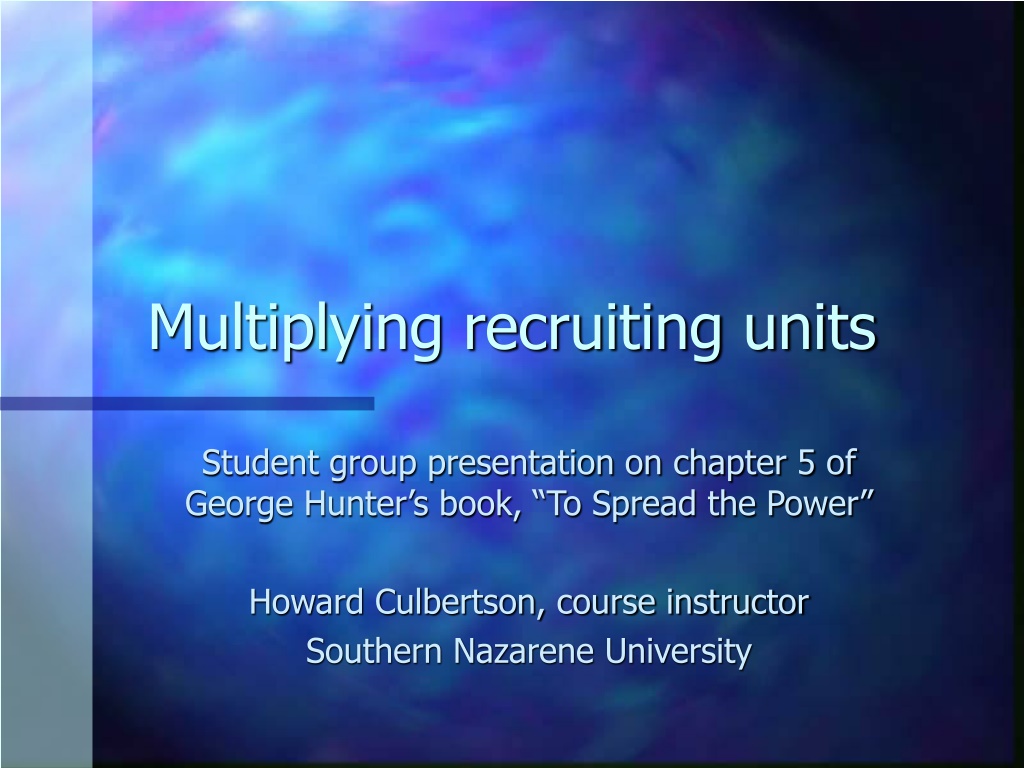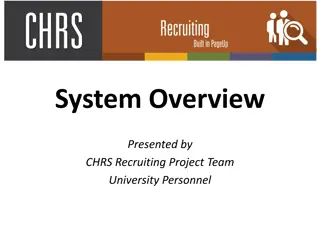Multiplying recruiting units
This presentation delves into the key relationships between church growth and the number, age, and mission of church units, emphasizing the correlation between membership strength and the number of units. It also discusses the importance of starting new churches for denominational growth, Sunday school multiplication as a growth strategy, and insights from Richard Myers on church growth through program expansion. The content highlights the significance of recruiting units and the impact of church programs on overall expansion.
Download Presentation

Please find below an Image/Link to download the presentation.
The content on the website is provided AS IS for your information and personal use only. It may not be sold, licensed, or shared on other websites without obtaining consent from the author.If you encounter any issues during the download, it is possible that the publisher has removed the file from their server.
You are allowed to download the files provided on this website for personal or commercial use, subject to the condition that they are used lawfully. All files are the property of their respective owners.
The content on the website is provided AS IS for your information and personal use only. It may not be sold, licensed, or shared on other websites without obtaining consent from the author.
E N D
Presentation Transcript
Multiplying recruiting units Student group presentation on chapter 5 of George Hunter s book, To Spread the Power Howard Culbertson, course instructor Southern Nazarene University
Key relationships between growth and: A church s membership strength The number, age, and mission of the church s units (at every level)
General Principle There is a correlation between a church s number of units and its membership strength.
Basic Principles of Denominational Growth Growing denominations start more churches than they close. Declining denominations close more churches than they start.
Points from Richard Myers Program Expansion: The Key to Church Growth 1. The number of church school classes determines how many persons can participate in the church school. More classes, larger attendance Fewer classes, smaller attendance.
2. Correlation between program groups, church staff, and church membership Congregations with the same number of program groups and staff will have about the same: church membership worship attendance church school attendance women s society and youth fellowship groups.
3. There is a strong correlation between average Sunday school attendance and the number of members received by profession of faith. Myers felt that expansion of Sunday school programs will lead to the expansion of the entire church.
A world of trade-offs Larger, more established classes take a better care of current members. Newer, smaller classes are better at bringing new members into the church.
General Principle two: New units are generally more reproductive than older units.
Other factors important to this principle: Whether a group s mission includes reaching new people. Whether many of the groups are relatively new. Whether or not the groups relate to the target population
Principle three: Sometimes old units flanked by a new unit will experience growth. When a new class flanks an old stagnant one, the older of the two may experience growth.
Principle four: Old units that get new units started may experience growth.
Flake formula of Sunday School Growth Locate the prospects Enlarge the organization Enlist and train workers Go after the people
Modifications to the Flake Formula Baptist churches now do this annually Baptists insist on multiplying units using classes small enough for relationships to form They try to enroll as many people as possible One person is responsible to recruit and train new teachers for these new classes
Wesleys model Preach in as many places as you can. Start as many classes as you can. Do not preach without starting new classes.
Wesleys Classes Should be understood by their agenda They were not like small groups we are familiar with
People joining Wesleys classes made three commitments: To do good To avoid all known sin To pursue regularly the means of grace
Views on Wesleys Approach 1. Gloster Udy: these classes reflected Wesley s view that Christianity is not a solitary religion 2. David Lowes Watson: the classes were accountability groups 3. Hunter sees accountability as too legalistic. He feels the groups were created for liberation, not discipline. Wesley s objective is to help people to live as Christians
Wesleys Goals Wesley sought to return to the love, faith, hope, courage, and vision, of the Apostolic church His means of doing this was through his classes He hypothesized that the good fruit in the church would emerge when God s people met together in small house churches and classes as the early church did
Wesleys affirmation of the Church as a social phenomenon draws four on principles Power is available to awaken people in any setting to awaken people and enroll them in classes were the two objectives of field preaching and lay witness Awakened people experienced grace through the ministry of the cells, most often in hours of solitude following the cell meetings
Once gained, faith is maintained through fellowship within the society People also grow in completeness of love in fellowship
Nine steps to starting new groups within the church Define the target group of people Research the target audience and the ministry that would respond to their needs Find a committed lay person willing to be involved in the group. The person should identify with the target group
Train this person on how to start a new group Begin recruiting before the first group session Find an appropriate place to meet Stress the importance of the first several months. Keep accurate records of the experience for reference in starting later groups Build in monitoring and evaluation procedures
This PowerPoint presentation is available along with related materials and other PowerPoint presentations at http://home.snu.edu/~hculbert/ppt.htm






















